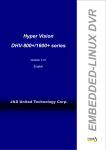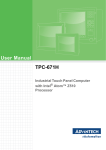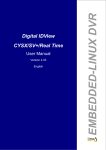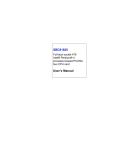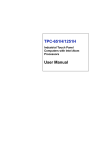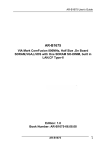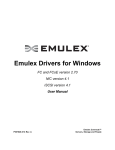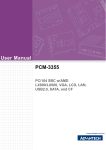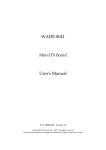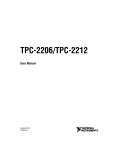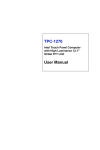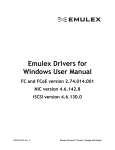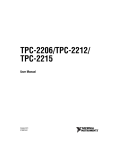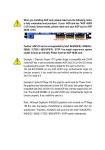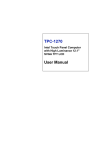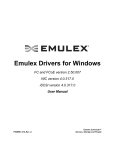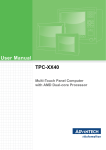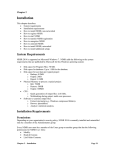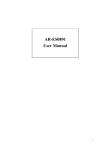Download PPC-2115/TPC-2515 User Manual
Transcript
PPC-2115/TPC-2515 User Manual PPC-2115/TPC-2515 User Manual August 2009 372053C-01 Support Worldwide Technical Support and Product Information ni.com National Instruments Corporate Headquarters 11500 North Mopac Expressway Austin, Texas 78759-3504 USA Tel: 512 683 0100 Worldwide Offices Australia 1800 300 800, Austria 43 662 457990-0, Belgium 32 (0) 2 757 0020, Brazil 55 11 3262 3599, Canada 800 433 3488, China 86 21 5050 9800, Czech Republic 420 224 235 774, Denmark 45 45 76 26 00, Finland 358 (0) 9 725 72511, France 01 57 66 24 24, Germany 49 89 7413130, India 91 80 41190000, Israel 972 3 6393737, Italy 39 02 41309277, Japan 0120-527196, Korea 82 02 3451 3400, Lebanon 961 (0) 1 33 28 28, Malaysia 1800 887710, Mexico 01 800 010 0793, Netherlands 31 (0) 348 433 466, New Zealand 0800 553 322, Norway 47 (0) 66 90 76 60, Poland 48 22 328 90 10, Portugal 351 210 311 210, Russia 7 495 783 6851, Singapore 1800 226 5886, Slovenia 386 3 425 42 00, South Africa 27 0 11 805 8197, Spain 34 91 640 0085, Sweden 46 (0) 8 587 895 00, Switzerland 41 56 2005151, Taiwan 886 02 2377 2222, Thailand 662 278 6777, Turkey 90 212 279 3031, United Kingdom 44 (0) 1635 523545 For further support information, refer to the Technical Support and Professional Services appendix. To comment on National Instruments documentation, refer to the National Instruments Web site at ni.com/info and enter the info code feedback. © 2007–2009 National Instruments Corporation. All rights reserved. Important Information Warranty The PPC-2115/TPC-2515 is warranted against defects in materials and workmanship for a period of one year from the date of shipment, as evidenced by receipts or other documentation. National Instruments will, at its option, repair or replace equipment that proves to be defective during the warranty period. This warranty includes parts and labor. The media on which you receive National Instruments software are warranted not to fail to execute programming instructions, due to defects in materials and workmanship, for a period of 90 days from date of shipment, as evidenced by receipts or other documentation. National Instruments will, at its option, repair or replace software media that do not execute programming instructions if National Instruments receives notice of such defects during the warranty period. National Instruments does not warrant that the operation of the software shall be uninterrupted or error free. A Return Material Authorization (RMA) number must be obtained from the factory and clearly marked on the outside of the package before any equipment will be accepted for warranty work. National Instruments will pay the shipping costs of returning to the owner parts which are covered by warranty. National Instruments believes that the information in this document is accurate. The document has been carefully reviewed for technical accuracy. In the event that technical or typographical errors exist, National Instruments reserves the right to make changes to subsequent editions of this document without prior notice to holders of this edition. The reader should consult National Instruments if errors are suspected. In no event shall National Instruments be liable for any damages arising out of or related to this document or the information contained in it. EXCEPT AS SPECIFIED HEREIN, NATIONAL INSTRUMENTS MAKES NO WARRANTIES, EXPRESS OR IMPLIED, AND SPECIFICALLY DISCLAIMS ANY WARRANTY OF MERCHANTABILITY OR FITNESS FOR A PARTICULAR PURPOSE. CUSTOMER’S RIGHT TO RECOVER DAMAGES CAUSED BY FAULT OR NEGLIGENCE ON THE PART OF NATIONAL INSTRUMENTS SHALL BE LIMITED TO THE AMOUNT THERETOFORE PAID BY THE CUSTOMER. NATIONAL INSTRUMENTS WILL NOT BE LIABLE FOR DAMAGES RESULTING FROM LOSS OF DATA, PROFITS, USE OF PRODUCTS, OR INCIDENTAL OR CONSEQUENTIAL DAMAGES, EVEN IF ADVISED OF THE POSSIBILITY THEREOF. This limitation of the liability of National Instruments will apply regardless of the form of action, whether in contract or tort, including negligence. Any action against National Instruments must be brought within one year after the cause of action accrues. National Instruments shall not be liable for any delay in performance due to causes beyond its reasonable control. The warranty provided herein does not cover damages, defects, malfunctions, or service failures caused by owner’s failure to follow the National Instruments installation, operation, or maintenance instructions; owner’s modification of the product; owner’s abuse, misuse, or negligent acts; and power failure or surges, fire, flood, accident, actions of third parties, or other events outside reasonable control. Copyright Under the copyright laws, this publication may not be reproduced or transmitted in any form, electronic or mechanical, including photocopying, recording, storing in an information retrieval system, or translating, in whole or in part, without the prior written consent of National Instruments Corporation. National Instruments respects the intellectual property of others, and we ask our users to do the same. NI software is protected by copyright and other intellectual property laws. Where NI software may be used to reproduce software or other materials belonging to others, you may use NI software only to reproduce materials that you may reproduce in accordance with the terms of any applicable license or other legal restriction. Trademarks National Instruments, NI, ni.com, and LabVIEW are trademarks of National Instruments Corporation. Refer to the Terms of Use section on ni.com/legal for more information about National Instruments trademarks. Other product and company names mentioned herein are trademarks or trade names of their respective companies. Members of the National Instruments Alliance Partner Program are business entities independent from National Instruments and have no agency, partnership, or joint-venture relationship with National Instruments. Patents For patents covering National Instruments products/technology, refer to the appropriate location: Help»Patents in your software, the patents.txt file on your media, or the National Instruments Patent Notice at ni.com/patents. WARNING REGARDING USE OF NATIONAL INSTRUMENTS PRODUCTS (1) NATIONAL INSTRUMENTS PRODUCTS ARE NOT DESIGNED WITH COMPONENTS AND TESTING FOR A LEVEL OF RELIABILITY SUITABLE FOR USE IN OR IN CONNECTION WITH SURGICAL IMPLANTS OR AS CRITICAL COMPONENTS IN ANY LIFE SUPPORT SYSTEMS WHOSE FAILURE TO PERFORM CAN REASONABLY BE EXPECTED TO CAUSE SIGNIFICANT INJURY TO A HUMAN. (2) IN ANY APPLICATION, INCLUDING THE ABOVE, RELIABILITY OF OPERATION OF THE SOFTWARE PRODUCTS CAN BE IMPAIRED BY ADVERSE FACTORS, INCLUDING BUT NOT LIMITED TO FLUCTUATIONS IN ELECTRICAL POWER SUPPLY, COMPUTER HARDWARE MALFUNCTIONS, COMPUTER OPERATING SYSTEM SOFTWARE FITNESS, FITNESS OF COMPILERS AND DEVELOPMENT SOFTWARE USED TO DEVELOP AN APPLICATION, INSTALLATION ERRORS, SOFTWARE AND HARDWARE COMPATIBILITY PROBLEMS, MALFUNCTIONS OR FAILURES OF ELECTRONIC MONITORING OR CONTROL DEVICES, TRANSIENT FAILURES OF ELECTRONIC SYSTEMS (HARDWARE AND/OR SOFTWARE), UNANTICIPATED USES OR MISUSES, OR ERRORS ON THE PART OF THE USER OR APPLICATIONS DESIGNER (ADVERSE FACTORS SUCH AS THESE ARE HEREAFTER COLLECTIVELY TERMED “SYSTEM FAILURES”). ANY APPLICATION WHERE A SYSTEM FAILURE WOULD CREATE A RISK OF HARM TO PROPERTY OR PERSONS (INCLUDING THE RISK OF BODILY INJURY AND DEATH) SHOULD NOT BE RELIANT SOLELY UPON ONE FORM OF ELECTRONIC SYSTEM DUE TO THE RISK OF SYSTEM FAILURE. TO AVOID DAMAGE, INJURY, OR DEATH, THE USER OR APPLICATION DESIGNER MUST TAKE REASONABLY PRUDENT STEPS TO PROTECT AGAINST SYSTEM FAILURES, INCLUDING BUT NOT LIMITED TO BACK-UP OR SHUT DOWN MECHANISMS. BECAUSE EACH END-USER SYSTEM IS CUSTOMIZED AND DIFFERS FROM NATIONAL INSTRUMENTS' TESTING PLATFORMS AND BECAUSE A USER OR APPLICATION DESIGNER MAY USE NATIONAL INSTRUMENTS PRODUCTS IN COMBINATION WITH OTHER PRODUCTS IN A MANNER NOT EVALUATED OR CONTEMPLATED BY NATIONAL INSTRUMENTS, THE USER OR APPLICATION DESIGNER IS ULTIMATELY RESPONSIBLE FOR VERIFYING AND VALIDATING THE SUITABILITY OF NATIONAL INSTRUMENTS PRODUCTS WHENEVER NATIONAL INSTRUMENTS PRODUCTS ARE INCORPORATED IN A SYSTEM OR APPLICATION, INCLUDING, WITHOUT LIMITATION, THE APPROPRIATE DESIGN, PROCESS AND SAFETY LEVEL OF SUCH SYSTEM OR APPLICATION. Compliance Electromagnetic Compatibility Information This hardware has been tested and found to comply with the applicable regulatory requirements and limits for electromagnetic compatibility (EMC) as indicated in the hardware’s Declaration of Conformity (DoC)1. These requirements and limits are designed to provide reasonable protection against harmful interference when the hardware is operated in the intended electromagnetic environment. In special cases, for example when either highly sensitive or noisy hardware is being used in close proximity, additional mitigation measures may have to be employed to minimize the potential for electromagnetic interference. While this hardware is compliant with the applicable regulatory EMC requirements, there is no guarantee that interference will not occur in a particular installation. To minimize the potential for the hardware to cause interference to radio and television reception or to experience unacceptable performance degradation, install and use this hardware in strict accordance with the instructions in the hardware documentation and the DoC1. If this hardware does cause interference with licensed radio communications services or other nearby electronics, which can be determined by turning the hardware off and on, you are encouraged to try to correct the interference by one or more of the following measures: • Reorient the antenna of the receiver (the device suffering interference). • Relocate the transmitter (the device generating interference) with respect to the receiver. • Plug the transmitter into a different outlet so that the transmitter and the receiver are on different branch circuits. Some hardware may require the use of a metal, shielded enclosure (windowless version) to meet the EMC requirements for special EMC environments such as, for marine use or in heavy industrial areas. Refer to the hardware’s user documentation and the DoC1 for product installation requirements. When the hardware is connected to a test object or to test leads, the system may become more sensitive to disturbances or may cause interference in the local electromagnetic environment. Operation of this hardware in a residential area is likely to cause harmful interference. Users are required to correct the interference at their own expense or cease operation of the hardware. Changes or modifications not expressly approved by National Instruments could void the user’s right to operate the hardware under the local regulatory rules. 1 The Declaration of Conformity (DoC) contains important EMC compliance information and instructions for the user or installer. To obtain the DoC for this product, visit ni.com/certification, search by model number or product line, and click the appropriate link in the Certification column. Conventions The following conventions are used in this manual: » The » symbol leads you through nested menu items and dialog box options to a final action. The sequence File»Page Setup»Options directs you to pull down the File menu, select the Page Setup item, and select Options from the last dialog box. This icon denotes a note, which alerts you to important information. This icon denotes a caution, which advises you of precautions to take to avoid injury, data loss, or a system crash. When this symbol is marked on a product, refer to the Safety section of Appendix A, Specifications, for information about precautions to take. When symbol is marked on a product, it denotes a warning advising you to take precautions to avoid electrical shock. When symbol is marked on a product, it denotes a component that may be hot. Touching this component may result in bodily injury. bold Bold text denotes items that you must select or click in the software, such as menu items and dialog box options. Bold text also denotes parameter names. italic Italic text denotes variables, emphasis, a cross-reference, or an introduction to a key concept. Italic text also denotes text that is a placeholder for a word or value that you must supply. monospace Text in this font denotes text or characters that you should enter from the keyboard, sections of code, programming examples, and syntax examples. This font is also used for the proper names of disk drives, paths, directories, programs, subprograms, subroutines, device names, functions, operations, variables, filenames, and extensions. Contents Chapter 1 General Information Introduction....................................................................................................................1-1 I/O Ports .........................................................................................................................1-1 Chapter 2 System Setup Important Safety Information ........................................................................................2-1 Setup ..............................................................................................................................2-2 Touchscreen Calibration..................................................................................2-3 Dual Display Setting ......................................................................................................2-4 Panel Mounting..............................................................................................................2-4 Chapter 3 Jumpers and Connectors Jumper and Connector Functions ..................................................................................3-1 Jumper and Connector Locations ..................................................................................3-2 Appendix A Specifications Appendix B Serial Port Settings Appendix C Watchdog Timer Programming Appendix D Accessory Kit Assembly Procedure Appendix E Touchscreen Configuration © National Instruments Corporation vii PPC-2115/TPC-2515 User Manual Contents Appendix F Fuse Replacement Appendix G Features in Windows XP Embedded (TPC-2515) Appendix H Technical Support and Professional Services Index PPC-2115/TPC-2515 User Manual viii ni.com 1 General Information This chapter includes general information about the PPC-2115/TPC-2515 Human Machine Interface (HMI). Introduction The PPC-2115/TPC-2515 touch panel computer, a state-of-the-art HMI based on an x86 platform, includes these key features: • Fanless—Because the system uses a low-power processor, it does not need fans, which often are unreliable and cause dust to circulate inside the equipment. • Bright display—The TFT LCD features a 15 in. display that meets industrial demands for clear interfaces. • Powerful communication capability—The PPC-2115/TPC-2515 is a powerful I/O interface for easy communication with other devices. The I/O interface includes serial ports, an RS485 port, a parallel port, and Ethernet and USB 2.0 support. • Windows Operating System—The PPC-2115 and TPC-2515 support the Windows XP and Windows XP Embedded platforms, respectively. I/O Ports The PPC-2115/TPC-2515 includes the following ports: • One parallel port that supports EPP/ECP/SPP modes • Three serial ports: RS232 (COM1 and COM3) and RS232/422/485 (COM4) • Two RJ-45 Ethernet ports: LAN 1 (10/100BaseT) and LAN2 (10/100/1000BaseT) • One PS/2 port: 6-pin mini-DIN port for keyboard and mouse • Two USB ports compliant with USB 2.0 • One CompactFlash slot • One PCMCIA slot • Three audio ports: one microphone, one line in, and one line out © National Instruments Corporation 1-1 PPC-2115/TPC-2515 User Manual Chapter 1 General Information Figure 1-1 shows the I/O port arrangement. 1 1 2 3 Parallel Port LAN1 LAN2 3 2 4 5 6 4 6 5 USB PS/2 COM3 (RS232) 7 7 8 9 8 9 COM4 (RS232/422/485) COM1 (RS232) VGA Figure 1-1. I/O Port Arrangement For more PPC-2115/TPC-2515 specifications, see Appendix A, Specifications. PPC-2115/TPC-2515 User Manual 1-2 ni.com 2 System Setup This chapter includes setup information for the PPC-2115/TPC-2515. Important Safety Information Before setting up the PPC-2115/TPC-2515, read these safety instructions carefully. Disconnect this equipment from any AC outlet before cleaning. Use a damp cloth. Do not use liquid or spray detergents for cleaning. For plug-in equipment, the power outlet socket must be located near the equipment and must be easily accessible. Keep this equipment away from humidity. Place this equipment on a reliable surface during installation. Dropping it or letting it fall may cause damage. The openings on the enclosure are for air convection. Protect the equipment from overheating. Do not cover the openings. Make sure the power source voltage is correct before connecting the equipment to the power outlet. Position the power cord so that people cannot step on it. Do not place anything over the power cord. All cautions and warnings on the equipment should be noted. If the equipment is not used for a long time, disconnect it from the power source to avoid damage by transient overvoltage. Never pour any liquid into an opening. This may cause fire or electrical shock. Never open the equipment. For safety reasons, only qualified service personnel should open the equipment. © National Instruments Corporation 2-1 PPC-2115/TPC-2515 User Manual Chapter 2 System Setup If one of the following situations arises, have service personnel check the equipment: • The power cord or plug is damaged. • Liquid has penetrated into the equipment. • The equipment has been exposed to moisture. • The equipment does not work well, or you cannot get it to work according to the user manual. • The equipment has been dropped and damaged. • The equipment has obvious signs of breakage. Do not leave this equipment in an environment where the storage temperature may go below –20 °C (–4 °F) or above 60 °C (140 °F). Doing so could damage the equipment. The equipment should be in a controlled environment. There is a danger of explosion if the battery is incorrectly replaced. Replace the battery only with the same or equivalent type recommended by the manufacturer. Discard used batteries according to the manufacturer’s instructions. Caution The sound pressure level at the operator’s position according to IEC 704-1:1982 is no more than 70 dB (A). Setup Follow these steps to set up the PPC-2115/TPC-2515: 1. Unpack the PPC-2115/TPC-2515. Be sure your kit includes the following items: • The PPC-2115/TPC-2515 HMI • Eight panel mounting clamps • Eight panel mounting screws • One 3-pin power connector and wire • One PS/2 splitter cable • One HMI Resource CD • One CompactFlash to IDE adapter card If any items are missing or damaged, contact National Instruments. Be sure system power is off before plugging in or pulling out the CompactFlash card. Caution PPC-2115/TPC-2515 User Manual 2-2 ni.com Chapter 2 2. System Setup Connect the power connector to 24 VDC power lines. Be sure to connect the positive, negative, and ground lines as shown in Figure 2-1. The power lines can be from either a power adapter or in-house power source. + – GND Figure 2-1. Power Connector 3. Connect the power connector to the power receptor on the PPC-2115/TPC-2515. The power receptor pin assignment is shown in Figure 2-2. GND – + Figure 2-2. Power Receptor and Pin Assignment 4. Press the power button to power on the system. Touchscreen Calibration The PPC-2115/TPC-2515 touchscreen should be correctly calibrated and ready to use when you power on the system. However, if the calibration is not correct or you want to choose custom calibration options, refer to Appendix E, Touchscreen Configuration. © National Instruments Corporation 2-3 PPC-2115/TPC-2515 User Manual Chapter 2 System Setup Dual Display Setting To use an auxiliary CRT monitor with the PPC-2115/TPC-2515, connect the monitor to the CRT port on the PPC-2115/TPC-2515. Follow these steps to configure the CRT monitor settings: 1. After powering on the system, click the Intel icon in the toolbar on the PPC-2115/TPC-2515 LCD monitor. 2. Select Graphics Options»Output Device. 3. The display options window appears, showing the currently active display device. Use this window to select and configure alternate display devices. Panel Mounting Follow these steps to mount the PPC-2115/TPC-2515 in a panel: Note 1. Be sure the adhesive waterproof gasket on the front bezel is in position. 2. Install the PPC-2115/TPC-2515 into the panel opening. (Refer to Appendix A, Specifications, for cutout dimensions.) 3. Attach the clamps included in the accessory pack to the holes in the bezel. 4. Insert the screws included in the accessory pack into the clamps. Tighten the screws to fasten the PPC-2115/TPC-2515 against the panel. The mounting panel thickness should be less than 6 mm (0.236 in.). PPC-2115/TPC-2515 User Manual 2-4 ni.com 3 Jumpers and Connectors This chapter describes the PPC-2115/TPC-2515 jumpers and connectors. Jumper and Connector Functions Table 3-1 lists the jumper and connector functions. Table 3-1. Mainboard Connectors and Jumpers Label © National Instruments Corporation Function Description CN1 VGA D-Sub 15-pin (female) on panel CN2 DC in DC power in connector (5.08 mm, 3-pin housing) CN3 PCMCIA One-slot PCMCIA connector CN4 LCD power LCD inverter connector CN5 PS2 Standard mini-DIN 6-pin supports keyboard and mouse CN7 USB Two USB type-A female CN9 IDE Internal IDE 44-pin (2 mm) connector CN10 PRT D-Sub 25-pin (female) CN11 CF CompactFlash socket CN12 Speaker out Internal speaker connector CN13 Mic in Audio mic in CN14 Line out Audio line out CN15 Line in Audio line in 3-1 PPC-2115/TPC-2515 User Manual Chapter 3 Jumpers and Connectors Table 3-1. Mainboard Connectors and Jumpers (Continued) Label Function Description CN16 * (JP1) LVDS LCD Internal 18-bit LVDS LCD connector CN17 * (JP3) Touch Internal touchscreen connector COM1 COM1 Serial port: COM1 RS232 COM3 COM3 Serial port: COM3 RS232 COM4 COM4 Serial port: COM4 RS232/422/485 S1 COM4 MODE1 Setting COM4 RS232/422/485 mode S2 COM4 MODE2 Setting COM4 RS422 master or slave mode JP4 Clear CMOS Clear CMOS SW1 Power switch System power switch Jumper and Connector Locations Figure 3-1 shows the jumper and connector locations. PPC-2115/TPC-2515 User Manual 3-2 ni.com Chapter 3 Jumpers and Connectors Figure 3-1. Mainboard Jumpers and Connectors © National Instruments Corporation 3-3 PPC-2115/TPC-2515 User Manual A Specifications Physical Weight .................................................... 5.5 kg (without HDD) Cutout dimensions.................................. 373.5 × 297.5 mm (suggested) © National Instruments Corporation A-1 PPC-2115/TPC-2515 User Manual Appendix A Specifications Dimensions 297 mm [11.693 in] 4.5 mm [0.177 in] 373 mm [14.685 in] 383 mm [15.079 in] 307 mm [12.087 in] 64 mm [2.52 in] PPC-2115/TPC-2515 User Manual A-2 ni.com Appendix A Specifications System Kernel CPU........................................................ Intel Celeron M (clock rate 600 MHz/1 GHz) BIOS....................................................... Award 4 Mbit flash memory South bridge ........................................... Intel 855GME/852GM GMCH/ICH4 chipset VGA ....................................................... Intel 855GME for PPC-2115/TPC-2515-A series; Intel 852GM for PPC-2115/TPC-2515-B series; supports 16 MB frame buffer with system memory; simultaneous support of CRT and LVDS flat panel display Ethernet .................................................. Intel 82562EZ and Intel 82551QM Ethernet controller; IEEE 802.3u protocol compatible Watchdog timer...................................... W83627 watchdog timer; 1.6 s timeout period IDE ......................................................... 2 EIDE channels support one IDE compact flash socket onboard and one 44-pin (2 mm) connector LCD Display type ........................................... TFT color LCD Size (diagonal) ....................................... 15 in. Maximum resolution .............................. 1024 × 768 (XGA) Maximum colors .................................... 256,000 Pixel pitch (W × H, mm)........................ 0.3075 × 0.3075 Viewing angle ........................................ 120 Luminance (cd/m2)................................. 350 © National Instruments Corporation A-3 PPC-2115/TPC-2515 User Manual Appendix A Specifications Contrast ratio ..........................................500 Operating temperature ............................0 to 50 °C (32 to 122 °F) (ambient) Backlight.................................................2 CCFL Backlight life time ..................................50,000 h There may be several bright or dark pixels on the LCD. This phenomenon is normal in LCD manufacturing. Note Touchscreen Touchscreen type ....................................Resistive Base glass construction...........................Tempered glass Resolution ...............................................1024 × 1024 Light transmission ..................................75% typical Controller................................................RS232 interface Power rating............................................3.3 to 5 V Durability................................................100 million touches Power Input voltage ...........................................18 to 32 VDC (the fuse becomes an open circuit if the input level exceeds 33 VDC) Typical ....................................................24 VDC, 2.0 A Fuse Rating......................................................T3.15 A, 250 V Size .........................................................5 × 20 mm Note When replacing the fuse, use only a fuse of the same type and rating. Note For your protection, the fuse is set to break if the input voltage exceeds 33 VDC. PPC-2115/TPC-2515 User Manual A-4 ni.com Appendix A Specifications Environment Operating temperature............................ 0 to 50 °C (32 to 122 °F) Storage temperature ............................... –20 to 60 °C (–4 to 140 °F) Humidity ................................................ 40 °C @ 10 to 95% relative humidity (noncondensing) Vibration ................................................ 1 grms (5 to 500 Hz) Maximum altitude .................................. 2,000 m Pollution Degree .................................... 2 Indoor use only Safety This product meets the requirements of the following standards of safety for electrical equipment for measurement, control, and laboratory use: • IEC 60950-1, EN 60950-1 • UL 60950-1, CSA 60950-1 Note For UL and other safety certifications, refer to the product label or the Online Product Certification section. Electromagnetic Compatibility This product meets the requirements of the following EMC standards for electrical equipment for measurement, control, and laboratory use: • EN 61326 (IEC 61326): Class A emissions; Basic immunity • EN 55011 (CISPR 11): Group 1, Class A emissions • AS/NZS CISPR 11: Group 1, Class A emissions • FCC 47 CFR Part 15B: Class A emissions • ICES-001: Class A emissions For the standards applied to assess the EMC of this product, refer to the Online Product Certification section. Note Note For EMC compliance, operate this product according to the documentation. © National Instruments Corporation A-5 PPC-2115/TPC-2515 User Manual Appendix A Specifications CE Compliance This product meets the essential requirements of applicable European Directives as follows: • 2006/95/EC; Low-Voltage Directive (safety) • 2004/108/EC; Electromagnetic Compatibility Directive (EMC) Online Product Certification Refer to the product Declaration of Conformity (DoC) for additional regulatory compliance information. To obtain product certifications and the DoC for this product, visit ni.com/certification, search by model number or product line, and click the appropriate link in the Certification column. Environmental Management NI is committed to designing and manufacturing products in an environmentally responsible manner. NI recognizes that eliminating certain hazardous substances from our products is beneficial to the environment and to NI customers. For additional environmental information, refer to the NI and the Environment Web page at ni.com/environment. This page contains the environmental regulations and directives with which NI complies, as well as other environmental information not included in this document. Waste Electrical and Electronic Equipment (WEEE) At the end of the life cycle, all products must be sent to a WEEE recycling center. For more information about WEEE recycling centers and National Instruments WEEE initiatives, visit ni.com/environment/weee. EU Customers ⬉ᄤֵᙃѻક∵ᶧࠊㅵ⧚ࡲ⊩ ˄Ё RoHS˅ Ёᅶ᠋ National Instruments ヺড়Ё⬉ᄤֵᙃѻકЁ䰤ࠊՓ⫼ᶤѯ᳝ᆇ⠽䋼ᣛҸ (RoHS)DŽ ݇Ѣ National Instruments Ё RoHS ড়㾘ᗻֵᙃˈ䇋ⱏᔩ ni.com/environment/rohs_chinaDŽ (For information about China RoHS compliance, go to ni.com/environment/rohs_china.) PPC-2115/TPC-2515 User Manual A-6 ni.com Appendix A Specifications Mercury Disposal and Recycling LCD lamp(s) in this monitor contain mercury. Dispose or recycle according to local, state or federal laws. Consult the Electronic Industries Alliance at www.eiae.org for more information. For specific information on lamp disposal, consult www.lamprecycle.org. Cleaning If you need to clean the unit, use a soft, nonmetallic brush. Make sure that the unit is completely dry and free from contaminants before returning it to service. © National Instruments Corporation A-7 PPC-2115/TPC-2515 User Manual B Serial Port Settings COM1/COM3 Connector Pinout The following figure and table show the COM1/COM3 connector pinout. © National Instruments Corporation 1 5 6 9 Pin Signal 1 NDCD 2 NRX 3 NTX 4 NDTR 5 GND 6 NDSR 7 NRTS 8 NCTS 9 NRI B-1 PPC-2115/TPC-2515 User Manual Appendix B Serial Port Settings COM4 Connector Pinout and Settings The PPC-2115/TPC-2515 COM4 serial port is adjustable. You can set it to RS-232, RS-422, or RS-485, and it has auto data flow control capability. In other words, the PPC-2115/TPC-2515 can automatically detect the data flow direction at this port when two-wired RS-485 communication is activated. The following figure and table show the COM4 pinout and settings. 1 5 6 9 COM4 Mode S1 and S2 Setting RS232 Mode RS485 Mode RS422 Master Mode RS422 Slave Mode PPC-2115/TPC-2515 User Manual B-2 ni.com Appendix B © National Instruments Corporation Serial Port Settings PIN RS-232 RS-422 RS-485 1 NDCD TX– D– 2 NRX TX+ D+ 3 NTX RX+ — 4 NDTR RX– — 5 GND GND GND 6 NDSR — — 7 NRTS — — 8 NCTS — — 9 NRI — — B-3 PPC-2115/TPC-2515 User Manual Watchdog Timer Programming C Overview You can use the PPC-2115/TPC-2515 watchdog timer to monitor system software operation and take corrective action if the software fails to function after the programmed period. This appendix describes how to program the watchdog timer operation. The watchdog timer is built into the W83627HF I/O controller. It includes the following programmable functions: • You can enable and disable the timer via programming. • You can set the timer interval from 1 to 255 seconds or 1 to 255 minutes. • The timer generates an interrupt or resets the signal if the software fails to reset the timer after a timeout. Watchdog Timer Programming The watchdog timer I/O port address is 2E (hex) (the address port) and 2F (hex) (the data port). You must first assign the register address by writing the address value to address port 2E (hex), then write/read data to/from the assigned register through data port 2F (hex). © National Instruments Corporation C-1 PPC-2115/TPC-2515 User Manual Appendix C Watchdog Timer Programming Figure C-1 describes the watchdog timer programming procedure, and Table C-1 describes the watchdog timer registers. Unlock W83627 Select Watchdog Timer Register Enable Watchdog Timer Function Use Watchdog Timer Function Lock W83627HF Figure C-1. Watchdog Timer Programming Procedure PPC-2115/TPC-2515 User Manual C-2 ni.com Appendix C Watchdog Timer Programming Table C-1. Watchdog Timer Registers Address of Register (2E) Attribute Description Read/Write Value (2F) and description — 87 (hex) — Write this address twice to I/O address port 2E (hex) to unlock the W83627HF. 07 (hex) Write Write 08 (hex) to select the watchdog timer register. 30 (hex) Write Write 01 (hex) to enable the watchdog timer function. The default is disabled. F5 (hex) Write Set seconds or minutes as the timer unit. Write 0 to bit 3 (default): second. Write 1 to bit 3: minute. F6 (hex) Write 0: Stop timer 01 to FF (hex) (default): The count amount, in seconds or minutes, depends on the value set in register F5 (hex). This number determines how long the watchdog timer waits for the strobe before generating an interrupt or reset signal. Writing a new value to this register resets the timer to count with the new value. F7 (hex) Read/Write Bit 6: Write 1 to enable the keyboard to reset the timer. Write 0 to disable. Bit 5 (default): Write 1 to generate a timeout signal immediately and automatically return to 0. Bit 4 (default = 0): Read the watchdog timer status. 1 means the timer is timeout. AA (hex) © National Instruments Corporation — Write this address to I/O port 2E (hex) to lock the watchdog timer. C-3 PPC-2115/TPC-2515 User Manual Appendix C Watchdog Timer Programming Example Programs Example 1: Enable the Watchdog Timer and Set 10 s as the Timeout Interval ;----------------------------------------------------------Mov dx,2eh ; Unlock W83627HF Mov al,87h Out dx,al Out dx,al ;----------------------------------------------------------Mov al,07h ; Select registers of watchdog timer Out dx,al Inc dx Mov al,08h Out dx,al ;----------------------------------------------------------Dec dx ; Enable the function of watchdog timer Mov al,30h Out dx,al Inc dx Mov al,01h Out dx,al ;----------------------------------------------------------Dec dx ; Set second as counting unit Mov al,0f5h Out dx,al Inc dx In al,dx And al,not 08h Out dx,al ;----------------------------------------------------------Dec dx ; Set timeout interval as 10 seconds and start counting Mov al,0f6h Out dx,al Inc dx Mov al,10 Out dx,al ;----------------------------------------------------------Dec dx ; lock W83627HF Mov al,0aah Out dx,al PPC-2115/TPC-2515 User Manual C-4 ni.com Appendix C Watchdog Timer Programming Example 2: Enable the Watchdog Timer and Set 5 Min as the Timeout Interval ;----------------------------------------------------------Mov dx,2eh ; unlock W83627H Mov al,87h Out dx,al Out dx,al ;----------------------------------------------------------Mov al,07h ; Select registers of watchdog timer Out dx,al Inc dx Mov al,08h Out dx,al ;----------------------------------------------------------Dec dx ; Enable the function of watchdog timer Mov al,30h Out dx,al Inc dx Mov al,01h Out dx,al ;----------------------------------------------------------Dec dx ; Set minute as counting unit Mov al,0f5h Out dx,al Inc dx In al,dx Or al,08h Out dx,al ;----------------------------------------------------------Dec dx ; Set timeout interval as 5 minutes and start counting Mov al,0f6h Out dx,al Inc dx Mov al,5 Out dx,al ;----------------------------------------------------------Dec dx ; lock W83627HF Mov al,0aah Out dx,al © National Instruments Corporation C-5 PPC-2115/TPC-2515 User Manual Appendix C Watchdog Timer Programming Example 3: Enable the Mouse to Reset the Watchdog Timer ;----------------------------------------------------------Mov dx,2eh ; unlock W83627H Mov al,87h Out dx,al Out dx,al ;----------------------------------------------------------Mov al,07h ; Select registers of watchdog timer Out dx,al Inc dx Mov al,08h Out dx,al ;----------------------------------------------------------Dec dx ; Enable the function of watchdog timer Mov al,30h Out dx,al Inc dx Mov al,01h Out dx,al ;----------------------------------------------------------Dec dx ; Enable watchdog timer to be reset by mouse Mov al,0f7h Out dx,al Inc dx In al,dx Or al,80h Out dx,al ;----------------------------------------------------------Dec dx ; lock W83627HF Mov al,0aah Out dx,al PPC-2115/TPC-2515 User Manual C-6 ni.com Appendix C Watchdog Timer Programming Example 4: Enable the Keyboard to Reset the Watchdog Timer ;----------------------------------------------------------Mov dx,2eh ; unlock W83627H Mov al,87h Out dx,al Out dx,al ;----------------------------------------------------------Mov al,07h ; Select registers of watchdog timer Out dx,al Inc dx Mov al,08h Out dx,al ;----------------------------------------------------------Dec dx ; Enable the function of watchdog timer Mov al,30h Out dx,al Inc dx Mov al,01h Out dx,al ;----------------------------------------------------------Dec dx ; Enable watchdog timer to be strobed reset by keyboard Mov al,0f7h Out dx,al Inc dx In al,dx Or al,40h Out dx,al ;----------------------------------------------------------Dec dx ; lock W83627HF Mov al,0aah Out dx,al © National Instruments Corporation C-7 PPC-2115/TPC-2515 User Manual Appendix C Watchdog Timer Programming Example 5: Generate a Timeout Signal without Timer Counting ;----------------------------------------------------------Mov dx,2eh ; unlock W83627H Mov al,87h Out dx,al Out dx,al ;----------------------------------------------------------Mov al,07h ; Select registers of watchdog timer Out dx,al Inc dx Mov al,08h Out dx,al ;----------------------------------------------------------Dec dx ; Enable the function of watchdog timer Mov al,30h Out dx,al Inc dx Mov al,01h Out dx,al ;----------------------------------------------------------Dec dx ; Generate a time-out signal Mov al,0f7h Out dx,al ;Write 1 to bit 5 of F7 register Inc dx In al,dx Or al,20h Out dx,al ;----------------------------------------------------------Dec dx ; lock W83627HF Mov al,0aah Out dx,al PPC-2115/TPC-2515 User Manual C-8 ni.com D Accessory Kit Assembly Procedure This appendix explains how to connect to a CD-ROM via the CompactFlash slot. CompactFlash to IDE Transfer Kit Assembly Follow these steps to connect to a CD-ROM via the CompactFlash slot: 1. Connect the IDE cable to the adapter board. 2. Insert the adapter board into the CompactFlash slot. 3. Connect the CD-ROM to the IDE cable. 4. Connect the external power line to the CD-ROM. © National Instruments Corporation D-1 PPC-2115/TPC-2515 User Manual Touchscreen Configuration E This appendix explains how to configure the PPC-2115/TPC-2515 touchscreen using the PenMount Control Panel. Touchscreen Calibration Click the pm icon in the lower right corner of the screen to access the PenMount Control Panel. The panel contains five functions: Calibrate, Draw, and Option, all described below, Multiple Monitors, and About. Multiple Monitors is for calibrating multiple touchscreen displays only; it does not apply to the PPC-2115/TPC-2515, which allows only one touchscreen display. About shows the driver version. Calibrate There are two ways to calibrate the touchscreen—standard calibration and advanced calibration. Use standard calibration to adjust newer touchscreens, which need only a few calibration points. Follow these steps to use standard calibration: Note 1. Click the Standard Calibration button on the Calibrate tab of the PenMount Control Panel. 2. A screen with a small red square appears. Touch the red square on this screen and the screens that follow it. 3. The calibration is complete after you touch the red square on the fifth screen. Press <ESC> to skip any calibration screen. © National Instruments Corporation E-1 PPC-2115/TPC-2515 User Manual Appendix E Touchscreen Configuration Use advanced calibration for older touchscreens, which may need additional calibration. Advanced calibration uses 4, 9, 16, or 25 calibration points. Follow these steps to use advanced calibration: 1. On the Calibrate tab of the PenMount Control Panel, set the number of calibration points in the Advanced Mode drop-down menu. 2. Select Plot calibration data if desired. If you enable Plot calibration data, blue lines show linearity before calibration, and black lines show linearity after calibration. 3. Click the Advanced Calibration button. 4. A screen with a small red square appears. Touch the red square on this screen and the screens that follow it. 5. The calibration is complete after you touch the red square on the last screen. Draw The draw option tests touchscreen operation by showing touch location. Follow these steps to use the draw function: 1. Click the Draw button in the Draw tab of the PenMount Control Panel. 2. Touch several points on the screen. The screen should show the points you touched. 3. Click Menu»Clear Screen to clear the drawing. Option Use the controls in the Option tab to set the operation mode and beep sound. In Stream Mode, the mouse functions normally. In Point Mode, the mouse has only a click function; onscreen dragging is disabled. Select Enable Beep Sound to turn on the beep sound. Adjust the beep frequency and duration using Beep Frequency and Beep Duration. Click Back to Default to restore the defaults. PPC-2115/TPC-2515 User Manual E-2 ni.com F Fuse Replacement Caution Do not replace the fuse unless it is damaged. Do not replace the fuse with a differently rated fuse. For more information, see the fuse specifications in Appendix A, Specifications. Follow these steps to replace the fuse: 1. Remove the fuse cover. 2. Replace the damaged fuse with a new one. 3. Place the fuse cover back into position. © National Instruments Corporation F-1 PPC-2115/TPC-2515 User Manual G Features in Windows XP Embedded (TPC-2515) The TPC-2515 supports the Windows XP Embedded platform (commonly abbreviated XPe), which is a componentized version of the Windows XP Professional edition. This appendix explains the version information and the EWF utility for Windows XP Embedded. Version Information You can access the version information by selecting Start»All Programs» Utilities. The version information states the current XPe runtime information including hardware platform, version, build number, release date, XPe QFEs installed in the component database, and Windows XP Pro patches installed. EWF Enhanced Write Filter (EWF) provides an upper filter in the storage device driver stack that redirects disk write operations to volatile (RAM) or nonvolatile (disk) storage. EWF protects a volume from write access and offers the following benefits: • Write-protects one or more partitions on your system. • Enables read-only media, such as CD-ROM or flash, to boot and run. • Prolongs the life span of write-sensitive storage, such as CompactFlash. To disable/enable EWF, go to Start»All Programs»Utilities and select the EWF tab. The default setting is disabled. When EWF is enabled, the C: partition is protected from any disk writing. In this mode, any changes on the C: partition (including modifications to files or the registry) are redirected to memory. Thus, these changes are discarded in the next system startup. You can manually enable this mode after finishing all system changes such as installing your applications or adjusting system settings. © National Instruments Corporation G-1 PPC-2115/TPC-2515 User Manual Appendix G Features in Windows XP Embedded (TPC-2515) Login By default, XPe automatically logs into the Administrator account. The default password is password, all lower case, with no quotes. The Administrator account defaults are: PPC-2115/TPC-2515 User Manual • Login: Administrator • Password: password G-2 ni.com Technical Support and Professional Services H Visit the following sections of the award-winning National Instruments Web site at ni.com for technical support and professional services: • Support—Technical support at ni.com/support includes the following resources: – Self-Help Technical Resources—For answers and solutions, visit ni.com/support for software drivers and updates, a searchable KnowledgeBase, product manuals, step-by-step troubleshooting wizards, thousands of example programs, tutorials, application notes, instrument drivers, and so on. Registered users also receive access to the NI Discussion Forums at ni.com/forums. NI Applications Engineers make sure every question submitted online receives an answer. – Standard Service Program Membership—This program entitles members to direct access to NI Applications Engineers via phone and email for one-to-one technical support as well as exclusive access to on demand training modules via the Services Resource Center. NI offers complementary membership for a full year after purchase, after which you may renew to continue your benefits. For information about other technical support options in your area, visit ni.com/services, or contact your local office at ni.com/contact. • Training and Certification—Visit ni.com/training for self-paced training, eLearning virtual classrooms, interactive CDs, and Certification program information. You also can register for instructor-led, hands-on courses at locations around the world. • System Integration—If you have time constraints, limited in-house technical resources, or other project challenges, National Instruments Alliance Partner members can help. To learn more, call your local NI office or visit ni.com/alliance. © National Instruments Corporation H-1 PPC-2115/TPC-2515 User Manual Appendix H Technical Support and Professional Services If you searched ni.com and could not find the answers you need, contact your local office or NI corporate headquarters. Phone numbers for our worldwide offices are listed at the front of this manual. You also can visit the Worldwide Offices section of ni.com/niglobal to access the branch office Web sites, which provide up-to-date contact information, support phone numbers, email addresses, and current events. PPC-2115/TPC-2515 User Manual H-2 ni.com Index A EWF, G-1 example programs, watchdog timer, C-4 examples (NI resources), H-1 About calibration option, E-1 accessory kit assembly, D-1 C F Calibrate calibration option, E-1 CE compliance specifications, A-6 cleaning, A-7 COM1/COM3 connector pinout, B-1 COM4 connector pinout and settings, B-2 CompactFlash to IDE transfer kit assembly, D-1 connectors, 3-1 function descriptions (table), 3-1 locations (table), 3-3 conventions used in the manual, v fuse replacement, F-1 specifications, A-4 H help, technical support, H-1 I I/O ports, 1-1 arrangement (figure), 1-2 instrument drivers (NI resources), H-1 introduction, 1-1 D diagnostic tools (NI resources), H-1 dimensions, A-2 documentation conventions used in the manual, v NI resources, H-1 Draw calibration option, E-2 drivers (NI resources), H-1 dual display setting, 2-4 J jumpers, 3-1 function descriptions (table), 3-1 locations (table), 3-3 K KnowledgeBase, H-1 E L electromagnetic compatibility specifications, A-5 Enhanced Write Filter (EWF), G-1 environmental management specifications, A-6 environmental specifications, A-5 © National Instruments Corporation LCD specifications, A-3 login on TPC-2515, G-2 I-1 PPC-2115/TPC-2515 User Manual Index M fuse replacement, F-1 specifications, A-4 I/O ports, 1-1 introduction, 1-1 jumpers, 3-1 LCD specifications, A-3 mercury disposal and recycling specifications, A-7 online product certification specifications, A-6 panel mounting, 2-4 physical specifications, A-1 power connector (figure), 2-3 power receptor (figure), 2-3 power specifications, A-4 safety information, 2-1 specifications, A-5 serial port settings, B-1 specifications, A-1 system kernel specifications, A-3 system setup, 2-2 touchscreen calibration, 2-3 About, E-1 Calibrate, E-1 Draw, E-2 Multiple Monitors, E-1 Option, E-2 specifications, A-4 Waste Electrical and Electronic Equipment specifications, A-6 watchdog timer programming, C-1 example programs, C-4 overview, C-1 procedure (figure), C-2 registers (table), C-3 programming examples (NI resources), H-1 mercury disposal and recycling specifications, A-7 Multiple Monitors calibration option, E-1 N National Instruments support and services, H-1 O online product certification specifications, A-6 Option calibration option, E-2 P panel mounting, 2-4 physical specifications, A-1 pinouts COM1/COM3 connector, B-1 COM4 connector, B-2 power connector (figure), 2-3 power receptor (figure), 2-3 power specifications, A-4 PPC-2115/TPC-2515 CE compliance specifications, A-6 cleaning specifications, A-7 COM1/COM3 connector pinout, B-1 COM4 connector pinout and settings, B-2 CompactFlash to IDE transfer kit assembly, D-1 connectors, 3-1 dimensions, A-2 dual display setting, 2-4 electromagnetic compatibility specifications, A-5 environmental management specifications, A-6 environmental specifications, A-5 PPC-2115/TPC-2515 User Manual I-2 ni.com Index S TPC-2515 login, G-2 version information, G-1 Windows XP Embedded features, G-1 training and certification (NI resources), H-1 troubleshooting (NI resources), H-1 safety information, 2-1 specifications, A-5 serial port settings, B-1 setup, 2-2 software (NI resources), H-1 specifications, A-1 CE compliance, A-6 cleaning, A-7 dimensions, A-2 electromagnetic compatibility, A-5 environmental, A-5 environmental management, A-6 fuse, A-4 LCD, A-3 mercury disposal and recycling, A-7 online product certification, A-6 physical, A-1 power, A-4 safety, A-5 system kernel, A-3 touchscreen, A-4 Waste Electrical and Electronic Equipment compliance, A-6 support, technical, H-1 system kernel specifications, A-3 system setup, 2-2 V version information on TPC-2515, G-1 W Waste Electrical and Electronic Equipment compliance specifications, A-6 watchdog timer programming, C-1 example programs, C-4 enabling the keyboard to reset the watchdog timer, C-7 enabling the mouse to reset the watchdog timer, C-6 enabling the watchdog timer and setting 10 seconds as the timeout interval, C-4 enabling the watchdog timer and setting 5 minutes as the timeout interval, C-5 generating a timeout signal without timer counting, C-8 overview, C-1 procedure (figure), C-2 registers (table), C-3 Web resources, H-1 Windows XP Embedded features, G-1 EWF, G-1 login, G-2 version information, G-1 T technical support, H-1 touchscreen calibration, 2-3, E-1 About, E-1 Calibrate, E-1 Draw, E-2 Multiple Monitors, E-1 Option, E-2 specifications, A-4 © National Instruments Corporation I-3 PPC-2115/TPC-2515 User Manual













































